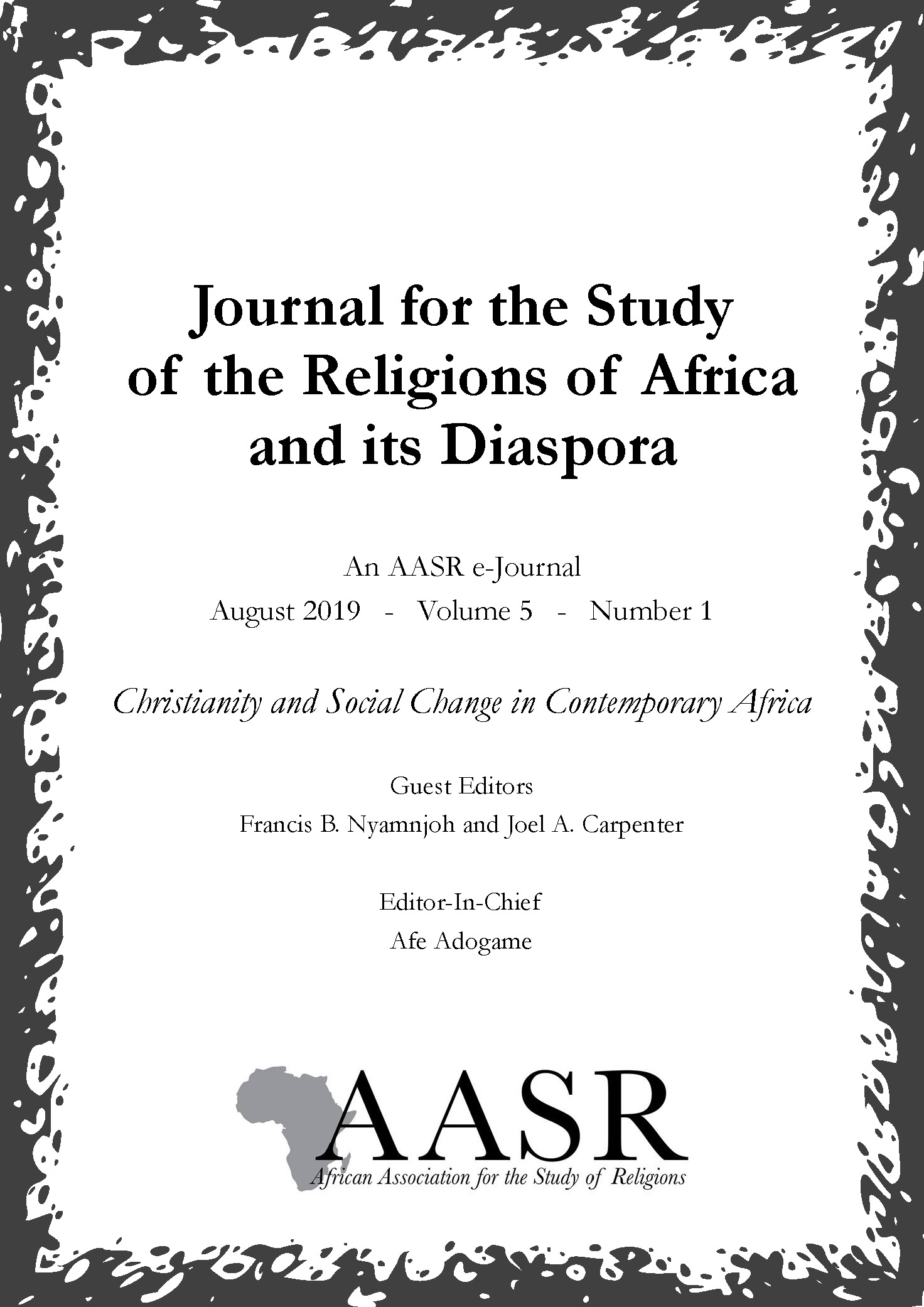“When Are You Going to Change Those Stones to Phones?” Social Media Appropriation by Pentecostal Churches in Cape Town
Main Article Content
Keywords
Social Media, Appropriation, Mediatisation, Pentecostal Churches, Platforms/Apps
Abstract
On May 15th 2016, the Southern Africa Zone 5 Pastor of Christ Embassy (CE), Pastor Rita, appeared on a live stream service that was broadcast to all the churches in the region to talk about the visit to the Holy Land in Jerusalem by Pastor Chris and his delegation. She later announced that the entire visit can be viewed on Love WorldSat Super User and King’s Chat and encouraged the use of the app to encourage viewership. Following the concept of mediatisation and looking at Pastor Rita’s communiques, this paper explores the appropriation of Social Media (SM) by Pentecostal churches (PCs) in Cape Town, South Africa. It seeks to understand how and to what extent innovation and competition propels PCs’ appropriation of SM to disseminate information, position themselves to attract the desired audience and maintain relevance in the face of mounting competition. Acknowledging the premise that the church is fast eroding and peoples’ lives are increasingly on the move, PC understand that the success of church depends on how they stay connected with Christians and evolve with the times. SM thus becomes the tool onthe- get-go, a way for accessing the church, and for PCs to stay connected with Christians, given their accessibility on mobile phones.
Article Metrics Graph
References
Asamoah-Gyadu, J. Kwabena. (2007). '"Get on the Internet!" Says the LORD: Religion, Cyberspace and Christianity in Contemporary Africa.' Studies in World Christianity 13:3: 225- 242. https://doi.org/10.3366/swc.2007.13.3.225
Asamoah-Gyadu, J. Kwabena. (2005). 'Anointing Through the Screen: Neo- Pentecostalism and Televised Christianity in Ghana'. Studies in World Christianity 11:1: 1- 28. https://doi.org/10.3366/swc.2005.11.1.9
Bagdikian, H. Ben. (2014). The New Media Monopoly: A Completely Revised and Updated Edition with Seven New Chapters. Boston, Massachusetts, Beacon Press.
Campbell, Heidi. (2013). Digital Religion: Understanding Religious Practice in New Media World. London/New York, Routledge.https://doi.org/10.4324/9780203084861
Campbell, Heidi. (2010). When Religion Meets New Media. New York: Routledge.https://doi.org/10.4324/9780203695371
Campbell, Heidi. (2004). 'Challenges Created by Online Religious Networks'. Journal of Media and Religion 3:2: 81-9.https://doi.org/10.1207/s15328415jmr0302_1
Cerulo, K. A., Ruane, J. M., and Chayko, M. (1992). 'Technological ties that bind: Mediagenerated primary groups'. Communication Research 19:1: 109-129. https://doi.org/10.1177/009365092019001005
Clark, Lynn Schofield. (2011). 'Considering religion and mediatisation through a case study of J+K's big day (The J K wedding entrance dance): A response to Stig Hjarvard'. Culture and Religion 12:02: 167-184. https://doi.org/10.1080/14755610.2011.579717
Christensen, H.R. (2012). 'Mediatization, deprivatization, and vicarious religion.' In Mediatization and Religion: Nordic Perspectives, pp. 63-78. Edited by S. Hjarvard and M. Lövheim. Gothenburg: Nordicom.
Einstein, Mara. (2008). Brands of Faith: Marketing Religion in a Commercial Age. New York; Routledge.
Finke, R., and Iannaccone, L. R. (1993). 'Supply-side explanations for religious change'. The Annals of the American Academy no. 527: 27-39.https://doi.org/10.1177/0002716293527001003
Gelfgren, Stefan. (2015). 'Why Does the Archbishop Not Tweet?: How Social Media Challenge Church Authorities'. Nordicom Review 36:1: 109-123. https://doi.org/10.1515/nor-2015-0009
Hackett, Rosalind I. J. and Soares, Benjamin, F. (2015). 'Introduction.' In New Media and Religious Transformations in Africa, pp. 1-16. Edited by Rosalind I.J. Hackett and Benjamin F. Soares. Bloomington & Indianapolis: Indiana University Press.
Hamberg, Eva M. and Pettersson, Thorleif. (1994). 'The Religious Market: Denominational Competition and Religious Participation in Contemporary Sweden'. Journal for the Scientific Study of Religion 33:3: 205-216. https://doi.org/10.2307/1386686
Hjarvard, Stig. (2016). 'Mediatization and the changing authority of religion'. Media, Culture & Society 38:1: 8-17.https://doi.org/10.1177/0163443715615412
Hjarvard, Stig. (2011). 'The mediatization of religion: theorising religion, media and social change'. Culture and Religion 12:2: 119-135.https://doi.org/10.1080/14755610.2011.579719
Hjarvard, S. (2008). 'The mediatisation of religion: A theory of the media as agents of religious change'. Northern Lights 6:1: 9-26.https://doi.org/10.1386/nl.6.1.9_1
Hoover, Stewart. (2006). Religion in the Media Age. New York: Routledge. https://doi.org/10.4324/9780203503201
Hoover, Stewart, and Lynn S. Clark. (2002). Practicing religion in the age of the media: explorations in media, religion, and culture. New York: Columbia University Press. https://doi.org/10.7312/hoov12088
Kaplan, M. Andreas, and Michael Haenlein. (2010). 'Users of the world, unite! The challenges and opportunities of Social Media'. Business Horizons 53: 59-68. https://doi.org/10.1016/j.bushor.2009.09.003
Kleinman Zoe. (2016). 'Tech inspired by faith booms in Africa'. BBC News, 6 September 2016. http://www.bbc.com/news/business-37249513. Accessed 12/10/2016.
Lövheim, Mia and K. Lundby. (2013). 'Mediated religion across time and space: A case study of Norwegian newspapers'. Nordic Journal of Religion and Society 26 :1: 25-44. https://doi.org/10.18261/ISSN1890-7008-2013-01-03
Markham, N. Annette. (2013). 'Fieldwork in Social Media: What Would Malinowski Do'? Qualitative Communication Research 2:4: 434-446.https://doi.org/10.1525/qcr.2013.2.4.434
McChesney, Robert, (2004). 'The political economy of international communication'. In Who Owns the Media?: Global Trends and Local Resistance, pp. 3-22. Edited by N. Thomas Pradip and Zaharom Nain. Penang/London: Southbounds/Zed books.
Meyer, Birgit. (2004). '"Praise the Lord": Popular cinema and Pentecostalite style in Ghana's new public sphere'. American Ethnologist 31:1: 92-110. https://doi.org/10.1525/ae.2004.31.1.92
Nyamnjoh, Francis. (2015). 'Forward'. In New Media and Religious Transformations in Africa, pp. vii-xii. Edited by Rosalind I. J. Hackett, and Benjamin F. Soares. Bloomington & Indianapolis: Indiana University Press.
Nyamnjoh, Francis. (2004). 'Global and local trends in media ownership and control: Implications for cultural creativity in Africa'. In Situating Globality: African Agency in the Appropriation of Global Culture, pp.57-89. Edited by Wim Van Binsbergen, and R. Van Dijk. Leiden and Boston: Brill. https://doi.org/10.1163/9789047412557_005
Ramaswamy, Venkat, and Francis, J. Gouillart. (2010). The power of co-creation. New York: Free Press.
Russell, C. (1993). The master trend: How the baby boom generation is remaking America. New York: Perseus.https://doi.org/10.1007/978-1-4899-6016-0
Schulz, Winifried. (2004). 'Reconstructing Mediatization as an Analytical Concept'. European Journal of Communication 19:1: 87-101.https://doi.org/10.1177/0267323104040696
van Dijck, José. (2013). The culture of connectivity: A critical history of social media. Oxford: Oxford University Press.https://doi.org/10.1093/acprof:oso/9780199970773.001.0001
Villi, Mikko and Matikainen, Janne. (2016). 'Participation in Social Media: Studying Explicit and Implicit Forms of Participation in Communicative Social Networks'. Media and Communication 4:4: 109-117. https://doi.org/10.17645/mac.v4i4.578


